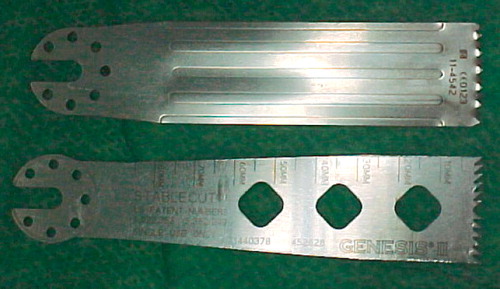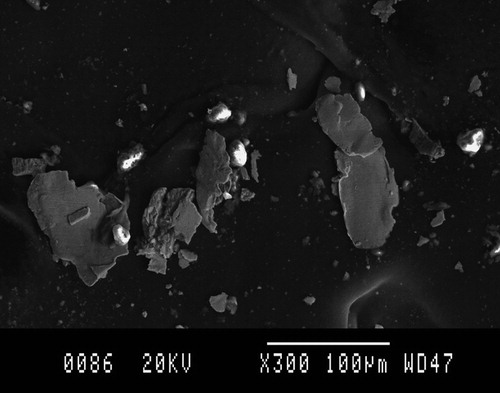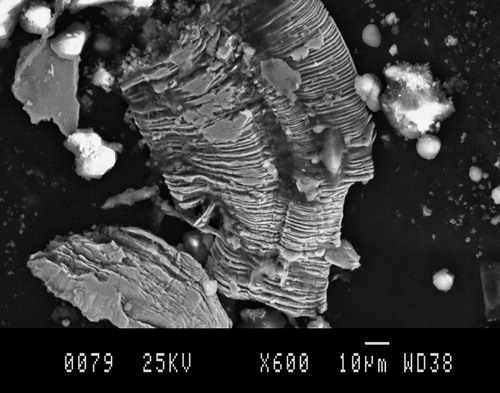Abstract
Background Metal particles are generated during bone preparation in knee arthroplasty. These particles may produce third-body wear, or may have a role in osteolysis. Knowledge of their characteristics may help in the development of methods to reduce the amount of metal debris during bone cutting procedures.
Material and methodsWe performed bony resection of the distal femur and proximal tibia on 15 pig knees, simulating a total knee arthroplasty (TKA). Metal debris was collected from the saw blades, cutting blocks and bone surfaces and cleaned for microanalysis.
Results The average loss of metal from the saw blades was 1.13 mg. The average volume of a wear particle was 3.4 × 10-16m3. From this, it was estimated that approximately 500,000 particles are released from the saw blade alone. Material analysis of the particles indicated that the majority originated from the metallic cutting guides, suggesting that many millions of wear particles would be generated during the surgical procedure. Two particle shapes predominated: platelet shape and ploughed shape.
Interpretation Wear particles are produced during resection for a TKA. These may enter the artificial articulation and cause accelerated wear and macrophage activation. Redesign of cutting blocks and saw blades may reduce the amount of debris produced during surgery.
The possibility that elevated temperatures can cause bone necrosis during saw resection for total knee arthroplasty (TKA) has been recognized (Toksvig-Larsen et al. Citation1991, Citation1992). To our knowledge, one other potential problem that not been reported is the generation of metal debris from the metallic blades and cutting guides used for bone resection. The particles are often difficult, if not impossible, to remove completely from the wound. In the environment of a prosthetic implant, these particles may increase the wear (McKellop et al. Citation1995) and contribute to the osteolytic process (Murray and Rushton Citation1990, Nasser et al. Citation1990, Buly et al. Citation1992, Schmalzried et al. Citation1992, McGee et al. Citation2000).
We investigated the origin of particles that are generated during bone preparation in knee arthroplasty.
Material and methods
We performed bony cuts for TKA on the distal femurand proximal tibia of 15 pig knees.The bones were heated to approximately 37°C before cutting began. The cutting blocks and blades were from the Genesis knee system (Smith and Nephew, Memphis, TN, USA). A practicing orthopedic surgeon experienced in TKA performed all the bony cuts. The bone was placed rigidly in a vice, and an air-driven oscillating saw (Microaire, Charlottesville, VA, USA) wasused, powered by bottled industrial-grade nitrogen at 60 psi. The operative procedure wasc onducted 5 times using conventional-shaped blades on a captured block, 5 times using ridged blades on a captured block, and five times using ridged blades on a non-captured block.
Saw blades and guide blocks
Unlike the blocks that are used for multiple procedures, the saw blades were single-use only. We used two blade types (). We compared (1) a non-conventional style with ridges to reduce surface area while still permitting waste to collect in the crevices between the ridges, with (2) a conventional flat blade, which uses holes cut through the blade to allow for waste material to collect. We used two styles of cutting block, the captured (slotted) and non-captured (chamfer) blocks. The captured block has grooves in which the saw blade is placed to accurately guide resection. The chamfer block provides angled surfaces against which the blade can be pressed during cutting.
Analysis of equipment before use
To determine the amount of material removed from the blades, they were removed individually from their packaging and weighed. We used powder-less latex gloves to handle the blades, in order to eliminate the possibility of any contamination. The blades were weighed using analytical scales (Mettler-Toledo, Greifensee, Switzerland) with a precision of 10 μg.
Particle collection
Bone chips, tissues and debris collected on the surface of the cutting equipment were placed in methylated spirits. A Teflon-coated magnetic stirring bar (Kartell, Milan, Italy) was used to collect the particles. The samples were heated to 60°C in 1-hour cycles to break down the fats and tissue in order to free trapped wear debris. This was repeated 10 times over 4 days.
Particle analysis
Using a light microscope, metal debris was wiped from the stirring bar. We used a JOEL JXA 840A electron probe microanalyzer (JEOL, Akishima, Japan) to examine the shape and size of the wear particles. The particles were analyzed to determine their origin using spectrum analysis software. Digital images were taken in order to measure particle sizes manually and to determine the distribution of particle size within the sample. We used X-ray diffraction (XRD) analysis to determine the composition of materials in both the blocks and saw blades.
Analysis of equipment after use
To ensure accurate weighing after use, the blades were cleaned thoroughly using disinfectant and hexane. They were analyzed visually, with special attention being paid to any deformation of the blade and for the presence of scratches. Hardness tests were conducted on all blades and blocks using the Rockwell Hardness Tester. The tester was set with a 150-kg load and a diamond cone, which produced readings in Rockwell C (a standard engineering measure of material hardness).
After establishing that the data followed a normal distribution, we performed statistical analysis of weight loss using two-way factorial ANOVA.
Results
Change in weight of blades
The average loss of metal from the saw blades was 1.13 mg (). There was no statistical difference in the amount of material lost from the different blades (p = 1.0) or with the use of different blocks (p = 1.0).
Table 1. Average amount of material removed (g) from the blades
Electron microprobe analysis
Two particle shapes were mainly seen within the samples. Platelet particles () were commonly formed during running-in of equipment, as is the case when a new blade comes in contact with the guide block surface. Ploughing particles () are generated when a harder material slides against a softer material, causing the asperities of the harder material to remove (i.e. plough through) the asperities of the softer material. There was a much higher concentration of platelets, with only a small proportion of ploughed particles evident throughout the wear sample. There appeared to be no difference between the particle shapes found in the wear debris from the conventional blades and the ridged blades.
Particle size was measured manually from the images taken with the electron microscope. This became the only option for particle size analysis, as the presence of small amounts of bone and tissue particles in the wear samples made it impossible to analyze them directly in a particle counter. We measured 300 wear particles for both the conventional and the ridged-style blades. There appeared to be no difference in the distributions of particle size between the two blade samples. A high frequency of smaller particles in the 1–20 μm range was evident. Most of these particles were platelets, with ploughing particles generally being larger than 20 μm. The highest concentration of particles appeared to be those approximately 1–2 μm in size. The particle distribution suggests that the average particle size is 3 μm in the major dimension (). Assuming that a wear particle can be roughly compared to a spherical shape, we calculated the average volume of a wear particle to be 3.39 × 10-16m3. From this, we estimated that approximately 500,000 particles are removed from the blade alone during use.
Using the electron probe microanalyzer in conjunction with spectrum analysis software, it was possible to determine the composition of the two stainless steel components (blocks and blades). We used this information to determine the origin of the wear debris and found that the majority of both platelets and ploughed wear particles were block-derived material, contrary to earlier beliefs that most of the particulate material originates from the blades. We observed that the stainless steel content of the blocks and blades was quite similar, with a high concentration of iron (Fe) and chromium (Cr). Unlike the blade, however, the block contained traces of nickel (Ni) and copper (Cu). Anti-corrosion additives are often added to cast stainless steel ().
Hardness test
The finding that the majority of wear debris originated from the block led us to investigate the difference in material properties between the block and blade material in more detail. The Rockwell hardness test gave a good indication of why the material was in fact being removed from the block rather than from the blade, which was visibly worn ().
Table 2. Hardness values for saw blade and cutting block
Visual analysis of blades
Used blades appeared scratched on the sliding surfaces. Scratching did not appear to be deep, but was evident across most of the blade. We observed that the edge damage to the ridged blades was more severe than that incurred by the conventional blades. The surface damage, however, was more severe on the conventional blades than on the ridged blades.
Discussion
We selected the Genesis total knee system for this study because it allows the use of both fully captured and uncaptured cutting guides. We hypothesized that the uncaptured blocks would produce less metal debris, but this did not prove so. Though wear is only produced on one surface, it is possible that the surgeon pushes harder on the block when the blade is uncaptured – in an attempt to cut accurately. This increased pressure may generate more debris than when the blade is allowed to run through the captured block.
We acknowledge that there are many knee systems on the market and that these systems may be used with several different cutting blades, thus producing variable numbers of wear particles. Also, surgeons with different levels of experience will produce different amounts of debris, depending on their skill in cutting. Furthermore, the density of the bone at any given operation will affect the difficulty of cutting and the subsequent generation of debris. Our study cannot give an absolute figure for generation of metal particles by any given surgeon using a particular implant on a particular patient. What it can do is to highlight a potentially important clinical problem: metal debris formed during TKA surgery.
Following bony resection for TKA, there is often staining of the bone cuts with metallic debris. Lavage of the interface may remove many of these particles, but others are almost certainly retained in the subimplant bony interface. Research into cellular responses to the presence of implant wear debris suggests that particle size and composition play a large role in determining how a cell will react to the presence of such debris, with small particles being the most damaging at the cellular level (Pazzaglia Citation1987). Analysis of wear debris from prosthetics that had failed revealed that wear particles were rarely larger than 5 μm, with the maximum diameter rarely exceeding 1 μm (Willert and Buchhorn Citation1999). These particles are smaller than most of the particles we found; however, we observed a high concentration of particles in the 1–2 μm range which could elicit a macrophage response. Also, smaller particles may have been produced in our study but they may not have been measurable from the images collected during microanalysis.
One factor that is more important than macrophage activation is the potential for the metal particles to produce third-body wear. With many of the particles produced in our study being greater than 20 μm and a large number being in the vicinity of 100 μm, if these are retained in the joint (which is probably the case despite the best efforts of the surgeon), they are likely to cause component scratching and accelerated polyethylene wear.
Spectrum analysis indicated that most of the debris produced originated from the guide block. This was an unexpected finding, until analysis of the hardness of the blades and cutting blocks showed that the stainless steel of the blocks is of a softer material. Unfortunately, the cutting blocks were not weighed. This was because we did not suspect that debris would be generated from the blocks, and we also felt that material retained within the slots of the blocks might invalidate the results. The fact that most of the material comes from the guide block suggests that many millions of wear particles are generated during knee replacement surgery. Further studies examining wear particles from blocks of different materials and of different age should be undertaken to investigate the problem of debris generation in greater depth.
We believe that improvement of the surface finish of saw blades and cutting blocks and more compatible matching of materials is the most effective way of reducing the production of wear particles. Changing the material from which the block or blade is manufactured could be of advantage. Equalizing the hardness of the stainless steel in the block and blade should lead to a reduction in wear; this might be achieved by raising the carbon levels, by treatment of the surface, or by changing the crystallographic structure of the material.
Surgeons should be aware of the hardness of the saw blades they are using, and of how this compares to the hardness of the cutting block used in TKA. Significant concerns have been raised as a result of our study, particularly concerning the possibility of early third-body wear of total knee replacements.
No competing interests declared.
- Buly R L, Huo M H, Salvati E, Brien W, Bansal M. Titanium wear debris in failed cemented total hip arthroplasty: An analysis of 71 cases. J Arthroplasty 1992; 7: 315–23
- McGee M A, Howie D W, Costi K, Haynes D R, Wildwnauer C I, Pearcy M J, McLean J D. Implant retrieval studies of the wear and loosening of prosthetic joints: a review. Wear 2000; 241: 158–65
- McKellop H A, Campbell P, Park S-H, Schmalzried T P, Grigoris P, Amstutz H C, Sarmiento A. The origin of submicron polyethylene wear debris in total hip arthroplasty. Clin Orthp 1995, 311: 3–20
- Murray D W, Rushton N. Macrophages stimulate bone resorption when they phagocytose particles. J Bone Joint Surg (Br) 1990; 72: 988–99
- Nasser S, Campbell P, Kilgus D J, Kossovsky N, Amstutz H C. Cementless total joint arthroplasty prostheses with titanium alloy articular surfaces: A human retrieval analysis. Clin Orthop 1990, 261: 171–85
- Pazzaglia U E, Dell'Orbo C, Wilkinson M J. The foreign body reaction in total hip arthroplasties: a correlated light-microscopy, SEM and TEM study. Arch Orthop Trauma Surg 1987; 106: 209–19
- Schmalzried T P, Jasty M, Harris W H. Periprosthetic bone loss in total hip arthroplasty. J Bone Joint Surg (Am) 1992; 74: 849–63
- Toksvig-Larsen S, Ryd L, Lindstrand A. On the problem of heat generation in bone cutting: Studies on the effects on liquid cooling. J Bone Joint Surg (Br) 1991; 73: 13–5
- Toksvig-Larsen S, Ryd L, Lindstrand A. Temperature influence in different orthopaedic saw blades. J Arthroplasty 1992; 7: 21–4
- Willert H G, BuchhornG H. The biology of the loosening of hip implants. European Instructional Course Lectures 1999, 4: 58–82




